 Pirates and Privateers Pirates and Privateers
The History of Maritime
Piracy
Cindy Vallar, Editor
& Reviewer
P.O. Box 425,
Keller, TX 76244-0425
    
Books for Adults ~ History: Piracy
The
Buccaneer's Realm
The Golden Age of Piracy (Cindy's review) (Irwin's
review)
How
History's Greatest Pirates Pillaged, Plundered, and
Got Away With It
Pirate
Hunting
The Sea Rover's
Practice
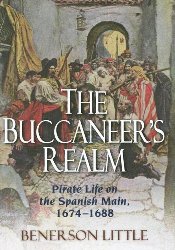
The Buccaneer’s Realm: Pirate
Life on the Spanish Main, 1674-1688
by Benerson Little
Potomac Books, 2007, ISBN 978-1-59797-101-0, US $29.95
    
Divided
into twenty-two chapters, The Buccaneer’s Realm
explores these 17th-century pirates and their way of
life in the Caribbean. But it is not just an
examination of the buccaneers; it also touches on
the region and those who lived there whether they
interacted with these rogues or not. Of particular
importance is the differentiation between buccaneers
and the pirates who came later. The topics covered
are the Spanish empire in the New World; the hunters
who became pirates; places where they sought safe
havens; their connections with Virginia, Africa, and
New England; religion and superstition; wrecks and
wreckers; language; sea battles; health and
medicine; sex; raids on land; swords and duels;
careening; marooning; and more. The book also
contains eight appendices that talk about the chasse-partie,
organization, captains and ships, published
accounts, barbecue, places attacked, exports and
plunder, weights and measures, and nautical jargon.
Notes, a bibliography, and an index complete the
package.
“Cornucopia” is the word that best describes The
Buccaneer’s Realm, for there are so many facts
and examples crammed into 267 pages that it’s
impossible to grasp the treasures found within the
book in one reading. Interspersed throughout are
quotes from those who were or knew the real
buccaneers, which serve to enrich this journey back
in time. Anyone wishing to learn more about the
buccaneers and the Caribbean of the later 17th
century should make this book a must read.
Review
Copyright ©2008 Cindy Vallar

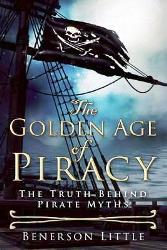
The Golden Age of Piracy: The
Truth behind Pirate Myths
by Benerson Little
Skyhorse, 2016, ISBN 978-1-5107-1302-4, US
$27.99
    
A pirate with an eye
patch, and perhaps a wooden leg,
wearing tall boots and an earring,
with a parrot on his shoulder, and
armed with cutlass and pistols.
He, or she, drinks rum, might
sport a tattoo, and curses up a
storm when he’s not saying, “Arr!”
This is the quintessential
swashbuckling buccaneer of yore .
. . or is it?
Most
people recognize at least some
falsity in this description.
It’s Hollywood’s version or how
writers portray pirates in their
novels. Within the pages of this
fascinating book, Little
explores the myths associated
with piracy and then delves into
primary accounts to distinguish
between fact and myth. He also
explores how these myths may
have originated, as well as why
real pirates didn’t act as they
do on screen and in print.
The
book is divided into two parts.
Six chapters address myths
dealing with pirate violence in
“For Some Body Must Be Beaten.”
The remaining six chapters focus
on pirate society in “The Custom
of the Coast.” This study
concerns the pirates who lived
and preyed between 1655 and
1725. The topics covered are
pirate flags and symbols on
them; “false optics” and two
famous pirates – Blackbeard and
Bartholomew Roberts – who
employed these techniques;
pirate ships and those upon
which they prey; techniques and
torture used to gain information
from prisoners; sea fights and
attacks; duels and weapons;
pirates and slaves; women
pirates and pirates of color;
pirates as revolutionaries and
rebels; pirate democracy and
utopias; and treasure.
Each
chapter opens with a summary
narrative that explores an
episode from history related to
the topic being discussed. The
endnotes include the sources
used in these condensations.
Three examples of such events
are Blackbeard’s blockade of
Charles Town, the buccaneers
crossing the Isthmus of Darien,
and the capture of Calico Jack
Rackham and his crew. Next,
Little discusses the myths
pertaining to each episode
before examining how they became
myths and what facts led to this
false picture of Golden Age
pirates.
Unfamiliar
terms are explained in context,
and Little clearly identifies
whether his conclusions are
drawn from known facts or are
educated hypotheses based on
what period documentation shows.
The source material listed in
the extensive bibliography
reveals not only the depth of
his research, but also the
numerous archival material and
primary documents he consulted.
The book includes a center
section of illustrations,
endnotes, and an index.
While
a few other volumes discuss
pirate myths, The Golden Age
of Piracy goes far beyond
these. Little sifts through the
popular mythology and purposeful
ideological speculation to
introduce readers to the real
pirates without turning a blind
eye to their cruelty and crimes.
That he does so in language that
any reader will understand makes
this a valuable resource and
worthwhile addition to any
pirate aficionado’s or
historian’s library.
Meet
the author
Review Copyright ©2016
Cindy Vallar


The Golden Age of Piracy: The
Truth behind Pirate Myths
by Benerson Little
Skyhorse, 2016 ISBN 978-1-5107-1302-4,
$27.99
review by Irwin Bryan
Once again Benerson Little has
produced a well-researched and in-depth
look at an aspect of piracy. Other books
of his have examined the tactics pirates
used and the life of a pirate. This
edition examines the myths that color our
perceptions of how pirates looked or acted
and what we may think about their
motivations and beliefs. With each myth
examined, the probable creation of the
myth is shown as well as how it may have
been perpetuated over the years. Several
historical examples of actual pirates are
presented to demonstrate the “truths” of
these myths.
As I began reading, my expectation was to
get some form of “true” or “false” answer
with everything presented. Instead, it
seemed like there was some truth to
everything. Or, maybe the topic was true
of the early buccaneers rather than the
pirates of the 1700s and vice-versa. This
was especially so with the chapter on
pirates flying a skull and crossbones
flag. An all red or all black flag was
similarly shown to serve the same purpose.
So many examples in this chapter had ships
with flags, reported to have flags, or not
having flags that the book’s subtitle
should have been called “The Truths Behind
Pirate Myths.”
Little provides a very thorough and
entertaining dissection of the image we
have of pirates. Why each detail of that
image is false is also explained. The
paragraph about pirates not wearing
bandanas or scarves on their heads was a
surprise to me. Certainly this was true of
sailors serving the guns during the
Napoleonic War!
The examination of the types of vessels
actually used by pirates may have some
aspiring pirate writers making hurried
changes to their manuscripts and leaving
the rest of us just disappointed. Who says
the truth doesn’t hurt?! Within this
same chapter, Little states “the musket
was the principal weapon of the
pirate.”(64) This may be another case of
this being truer for the buccaneers who
fought mostly on land, rather than the
shipboard pirates of the 18th century.
Another subject he looks at is how pirates
treated their victims. L’Olonnois is one
of the most brutal pirates; stories of his
brutality are carefully backed up with the
true sources for each action.
Surprisingly, the story of his death after
torture has no source. (78) Is this a
wishful myth of its own?
Two of the most famous pirates, Blackbeard
and Black Bart Roberts, have chapters of
their own dealing with all of the myths
about each of them. Roberts “is considered
by many to be . . . ‘the greatest pirate
of them all’.” (88) Some readers may find
it hard to tell that Little is being
sarcastic here, even though he provides
valid reasons why Roberts certainly was
not the greatest pirate. In the
summation to this chapter – prefaced by
saying “the facts, however, say otherwise”
– Little refutes that Roberts had any
noble motivations; states Blackbeard
engaged in piracy even after being
pardoned; Kidd really committed pirate
acts; and Henry Every and his crew
captured one rich ship and raped all the
women before going back to England where
he died in poverty. (100) Ironically,
none of these statements are supported
here by any endnote sources, although
readers who wish to hunt for such sources
will find some of them elsewhere in the
book.
In the chapter dealing with combat at sea,
Little writes “In the early eighteenth
century, pirates used the various black
flags with depictions of skull and crossed
bones or full skeletons to great effect.”
(108) So why is there a whole earlier
chapter mostly denying this? Perhaps this
book should have included a table or
timeline showing when myths are myths and
when they are true. Perhaps it would have
helped if he quantified how often or what
percentage of the time each myth held true
as opposed to his saying no, no, yes, yes
as is sometimes the case.
Another individual dealt with at some
length is Laurens de Graff. Twice he is
said to have served on Dutch ships with no
explanation of how or when. He is also
said to have been a Spanish gunner
assigned to the treasure ships, but
specific details on how or when he earned
this experience and reputation is not
mentioned. Although he may have been “an
extraordinarily talented fighting seaman,”
regardless of whether he sailed for the
Dutch or the Spanish, scant evidence is
provided to show that his ship was ever
attacked or boarded. (117) Prior to when
he became a pirate, de Graff may have just
been well-trained, rather than
experienced.
A chapter dealing mostly with why sailors
became pirates includes the issue of what
they did with their ill-gotten gains.
Little mentions “most pirates squandered
their shares of plunder on rum,
prostitutes, and related extravagant,
debauched celebration.”(143) I thought
this statement could have also been a myth
and deserved more coverage than it was
given.
One thing that I had hoped to read about
was whether the saying “Dead men tell no
tales” originated with the pirates or was
also just a myth. Without any survivors
this practice might have been hard to
document unless a pirate made a heartfelt
confession in an attempt to save his soul.
Could it have been examined by looking at
all the ships that vanished without a
trace each year on the Spanish Main? Would
it show an increase in the yearly totals
when the pirates were most active?
Unfortunately, it wasn’t discussed and so
I am left to wonder.
Some facts that were presented had only
one source and were not readily accepted
by me. This was especially so when I read
“Pirates of the early eighteenth century
often flew into a panic at the sight of a
man-of-war or other vessel capable of
making a stout fight.”(178) If they
generally had swift vessels that could
also sail closer to the direction of the
wind, escaping a warship should have been
relatively easy and no cause for panic.
One of the most bothersome things in this
book is the use of a story from Greek
mythology as an example of a possible
fact. If a real myth can be a fact, how
can the same person use facts to disprove
myths? Questions such as this make me
doubt some things said in this book. I
encourage you to read this new publication
for plenty of enjoyment and the knowledge
to be gained, and to use your own judgment
about what is presented herein.
Meet
the author
Review Copyright ©2017
Irwin Bryan

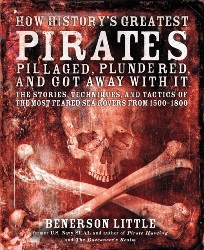
How History's Greatest
Pirates Pillaged, Plundered, and Got
Away With It
by Benerson Little
Fair Winds Press, 2011, ISBN
978-1-59233-443-8, US $19.99 / UK £14.99
/ CAN $21.99
    
The
subtitle for this book,
“The Stories,
Techniques, and Tactics
of the Most Feared Sea
Rovers from 1500-1800,”
explains what Little
focuses on as he
explores the piratical
careers of Kheir-Ed-Din
(Barbarossa), Grace
O’Malley, Francis Drake,
Diego the Mulatto, Henry
Morgan, Juan Corso,
Bartholomew Sharp,
Edward “Blackbeard”
Teach, Bartholomew
Roberts, Edward “Ned”
Low, Kanhoji Angria,
Cheng I Sao, and Jean
Laffite. Aside from the
many illustrations, the
book also includes
endnotes, a selected
bibliography, and an
index.
The
author’s background as
a former navy SEAL,
his study of
black-powder weaponry,
his experience as a
fencing instructor,
and his study of
primary evidence make
him eminently
qualified to write
this book and provide
it with greater
realism than someone
unfamiliar with ships,
their armament, and
the ways of pirates.
Little’s
intent here is to
demonstrate the
“romantic realism” of
pirates – showing them
as they were, not as
we think they were.
Since he focuses on
how they pirated,
readers clearly see
the similarities in
the techniques and
tactics pirates used
during this 300-year
span of time. It’s
interesting to learn
that some practices
date back further than
we might think.
What I
particularly like
about this book is the
variety of chosen
subjects. They are a
combination of the
most infamous and
least-known pirates;
they include men and
women, as well as
rogues from various
parts of the world,
rather than just those
of the Caribbean or
the golden age of
piracy. This book is a
highly entertaining
and informative look
at pirates and how
they plundered
throughout history.
Meet the
author
Review Copyright ©2011 Cindy Vallar

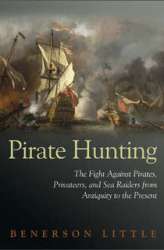
Pirate Hunting: The
Fight against Pirates, Privateers,
and Sea Raiders from Antiquity to
the Present
By Benerson Little
Potomac Books, 2010, ISBN
978-1-59797-291-8, US $29.95
One aspect of maritime
piracy often overlooked or merely
touched upon involves hunting
pirates. Little’s book aims to
correct this oversight. In fifteen
chapters (listed below), he
discusses strategies, techniques,
weapons, and ships used over the
centuries in various regions of
the world to hunt down and
eradicate pirates.
1. Of Black Flags and
Bloody Banners – The Pursuit of
Pirates and Privateers
2.
Heroes of the Fantastic – Pirate
Hunting in the Age of the Iliad
3.
In the Age of Ancient Empires –
Pirate Hunting in the
Mediterranean, 1450-700 BC
4.
Of Laurel Leaves and Pirate
Princes – Pirate Hunting in the
Mediterranean, 700 BC – AD 476
5.
The Scourge of the North –
Standing against the Norsemen,
780-1066
6.
A Sea Roving Free-for-All –
Pirate Hunting in the North
Seas, 1066-1492
7.
Of Faith, Galleys, and Greed –
Defeating the Mediterranean
Corsairs, 476-1492
8.
Spanish Galleons and Portuguese
Carracks – Plunderers Fighting
Plunderers, 1492 – 1654
9.
Of Blind Eyes and Opportunity –
A Introduction to the “Golden
Age,” 1655-1725
10.
The Real Pirates of the
Caribbean – Pirate Hunting in
the “Golden Age,” 1655-1725
11.
From the Mediterranean to the
North Sea – The War against
Pirates and Corsairs, 1493-1830
12.
Of Frigates and Cruisers – In
Pursuit of the Commerce Raiders,
1688-1865
13.
Pirates, Rebels, and Warriors –
Pirate Hunting in the East, 694
BC – AD 1896
14.
Death from Beneath the Waves –
Combating the Submarine Menace,
1914-1945
15.
Ships, SEALs, and Satellites –
The Return of the Pirate Hunters
Pirate
Hunting isn’t just about
searching for and destroying
pirates. Such concentration will
examine the topic within a void,
rather than incorporating the
parameters that necessitate the
hunt in the first place. The
author discusses sea roving
history, the weaponry and ships
both pirates and their suppressors
used, and the technological
changes that occur over time.
Maps,
illustrations, notes, an extensive
bibliography, and a detailed index
accompany the text. A few chapters
incorporate a broad time span;
this is because of the lack of
resources or because those
resources examine piracy from a
western perspective, rather than
the perspective of the region and
cultures where it occurs. One
example of this is the chapter on
eastern piracy, which extends from
the Persian Gulf and Red Sea to
Asian waters. Little attempts to
present a fairer picture in these
cases.
He
states in chapter one “[the]
destruction of these sea rovers is
the subject of this book,” rather
than the actual pirate hunters
(although a few are mentioned).
This is one drawback to the book.
With a few exceptions, these men
have little written about them,
other than their names and who
they captured. It would be nice to
know more of their personal
histories and how they actually
succeeded in their endeavors. The
title, too, is a bit of a
misnomer, for while the majority
of the book does deal with the
hunt for pirates, Little strays
from just that focus. Since one
country’s pirate is another
country’s hero, he prefers to call
these sea villains “sea rovers,”
which also allows him to
incorporate others who fall
outside the narrower parameters of
piracy. An example of this is
found in the fourteenth chapter
that covers submarine attacks
during the first and second World
Wars.
In
the preface, Little writes, “It is
from the point of view of those
who sought to stop or prevent sea
rovers of all sorts that this book
is written, and in a way, it is an
homage to all past and present who
have fought to defend life,
liberty, and, yes, even property
from the rover.” He wants the book
to be of use not just to general
readers, but also to those finding
ways to handle the problem of
maritime piracy. He succeeds in
both endeavors, and does so in a
manner that makes the text
interesting and compelling to
read.
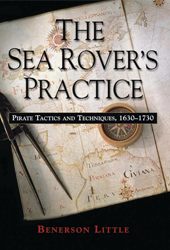
The Sea Rover’s
Practice: Pirate Tactics and
Techniques, 1630-1730
by Benerson Little
Potomac Books, 2005, ISBN
1-57488-910-9, US $27.5
also available in other formats
    
During
the 17th century
and the first
third of the
18th, sea rovers
-- pirates,
privateers*, and
buccaneers --
preyed on ships.
Fictional
accounts of this
time period tend
to romanticize
the era.
Nonfiction books
often examine
the period as a
whole and what
it was like to
be a pirate.
Neither,
however, spends
much time on how
sea rovers
accomplished
their seizure of
ships and
raiding of
towns. The
Sea Rover’s
Practice
corrects this
oversight, and
does so in such
a way that
anyone, general
reader or
scholar, can
learn the
methods these
marauders
employed. Little
uses quotes from
primary
documents to
illustrate these
practices,
allowing readers
to witness
firsthand what
and how sea
rovers
accomplished
their deeds.
Twenty-three
chapters cover
such information
as the perils
and rewards of
garnering wealth
by force, the
various types of
sea rovers who
roamed the seas,
how they
recruited and
organized their
brethren, the
types of vessels
and armament
they used, life
at sea and in
port, and how
they spied their
prey, gave
chase, and
acquired their
prizes at sea
and on land.
Aside from the
illustrations
that accompany
the text, the
reader will also
find seven
appendices
filled with
additional
treasures:
comparative
actions of sea
rovers; lexicons
pertaining to
sea rovers,
ships, and
mariners; those
sea rovers who
kept journals of
their exploits;
culinary history
and recipes; and
information on
ranges,
distances,
weights, and
measures from
the time period.
The text is
footnoted
throughout so
readers can
verify where
quotes and
details can be
found. A
detailed
bibliography and
index round out
the book.
No
self-respecting
sea rover should
be without this
manual!
Reenactors and
writers will
find The Sea
Rover’s
Practice
invaluable, but
anyone who
wishes a more
in-depth look
into the tactics
of pirates and
privateers will
not be
disappointed.
Meet
the author
*
Throughout the
book, Mr.
Little uses
“letter of
mart” rather
than “letter
of marque”
when
discussing
privateers.
I wondered
about this;
since the
reader is more
likely to
encounter the
latter, I
asked him
about
it. He
found “letter
of mart” used
in many
journals of
the period.
Among the
examples he
cited were:
Nathaniel
Uring’s The
Voyages and
Travels of
Captain
Nathaniel
Uring
from 1726
(Reprint:
Cassell and
Company, 1928)
...and
having
obtained a
Letter of Mart
from the
Governour, I
had orders to
make Prize of
such Vessels
of the
Enemies...
Thomas
Phillips’s The
Voyage of the
Ship Hannibal
of London, in
1693
(Excerpted in
Slave Ships
and Sailing
edited by
George Francis
Dow in 1927
and reissued
by Cornell
Maritime Press
in 1968.)
...so
that had no
colours flying
most of the
ingagement but
the king’s
pendant,
which, by
authority of
my letter of
mart, I fought
under..
Review
Copyright ©2006
Cindy Vallar

Read
reviews of Benerson Little's
novels

Click to contact me
Background image compliments
of Anke's Graphics |





